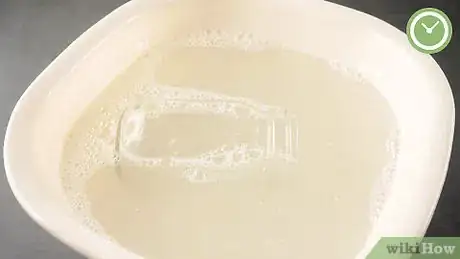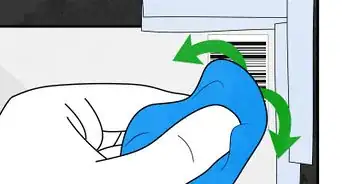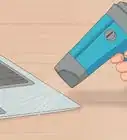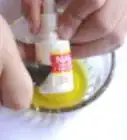This article was co-authored by Michelle Driscoll, MPH. Michelle Driscoll is the Owner of Mulberry Maids based in northern Colorado. Driscoll received her Masters in Public Health from the Colorado School of Public Health in 2016.
There are 17 references cited in this article, which can be found at the bottom of the page.
This article has been viewed 5,598,539 times.
Sticker residue can be annoying and difficult to deal with. Luckily, it is easy to remove. How you go about doing it, however, depends on how stubborn the residue is. This wikiHow will show you several ways of doing that.
Steps
Scraping, Pressing, and Rubbing
-
1Scrape the residue with scissors, an old credit card or a knife. If you’re using something sharp, make sure to align the blade flat against the surface. Otherwise you risk cutting grooves into the surface you’re trying to clean. Using a credit card allows you to scrape at the residue more liberally without risking damage to your surface.[1]
- Be careful using a knife or scissors on a glass or metal surface. These could easily get scratched. Try using one of the other methods for removing residue on glass or metal.
- Be sure to scrape away from you to avoid possible injury.
-
2Wrap masking tape around your fingers and press it against the residue. Ensure the tape makes a tight ring around your index and middle finger with the sticky side facing out. Press it against the surface and pull away. Notice the residue sticking to the tape, and repeat until you’ve lifted off as much residue as possible.[2]
- If the tape loses its stickiness before you’re finished, you can either rotate the ring or use a new length of tape.
Advertisement -
3Use your fingers to roll the adhesive into balls. This is more effective if the residue is fresh and not too resilient. Run your finger along the entirety of the residue, applying constant pressure. The residue will roll into balls that you can easily pluck off the surface.
-
4Rub the remaining residue with a wet wipe. You can either use wet wipes from the cleaning supply aisle or sanitizing wipes. Rub until you no longer feel any stickiness. You might have to let the surface dry and rub a few more times to completely rid it of residue.[3]
Using Soapy Water and Vinegar
-
1Fill a container with soapy water. This method works best with items like glass jars, which can be soaked and submerged without being damaged. Pick a container, like a large bowl, which can hold your item along with a few cups of water. Combine dishwashing detergent with hot water and fill your container.[4]
- Don’t fill the container to the brim, or it will overflow when you insert your item.
-
2Soak your surface for half an hour. Using the example of a glass jar, make sure the sticker and residue are completely submerged. Over this half hour, the glue will dissolve and the residue should come off easily.
-
3Rub the surface with soapy water. After soaking for half an hour, whatever residue is left shouldn’t be particularly difficult to remove. Dampen a cloth or rag, then rub until the residue comes off.[5]
-
4Rub off any remaining residue with vinegar. If there’s still some residue tenaciously sticking to your surface, add vinegar to the bowl of water. Whatever residue remains will already be softened after soaking, and will easily come off with vinegar.[6]
- Don’t use vinegar on marble, stone, aluminum or cast iron. It can corrode and damage these surfaces.[7]
Using Other Household Products
-
1Wear disposable gloves and protect your work space. Some of the household products used in this method might irritate the skin. Make sure to wear latex gloves to avoid this. If you’re working on a table or countertop, make sure to cover it in newspaper before proceeding.[8]
-
2Choose the right product for your surface. The right product depends on the surface you’re cleaning as well as the amount of residue you need to remove. Avoid using oily products on porous surfaces, and be careful about using corrosive products such as vinegar on metals and stone. Some household products are much more effective than products specifically designed for removing sticker residue.[9]
-
3Use rubbing alcohol for most surfaces. This is likely your best choice, as it doesn’t leave any residue, dries quickly and it’s best at neutralizing sticky residue.[10] If you don’t have rubbing alcohol, you can use vodka. Avoid sweet alcohols like rum as they can leave their own stickiness behind.[11]
- Moisten a rag or cloth with alcohol and rub the surface vigorously.
- After about 15 seconds of rubbing, check the surface to see how much residue is left. Continue rubbing until the surface is clear.
-
4Use cooking oil on nonporous surfaces. Letting some cooking oil soak into the sticky residue will allow you to remove it more easily. Because it lacks strong chemicals, it can be ideal for more sensitive surfaces. However, some will absorb the oil and cause a stain; avoid porous surfaces such as wood or cloth. If you’re unsure, test the oil on a small, inconspicuous spot of your surface. If it wipes off without a trace, you can go ahead.[12]
- Dab oil onto a paper towel and lay it over your surface.
- Wait a few minutes for the oil to soak into the sticky residue.
- Remove the paper towel, and scrape or rub the residue away.
-
5Combine 2 Tbs of cooking oil and 3 Tbs of baking soda. Baking soda mixed with cooking oil will form a paste that you can use to remove sticker residue from a surface. Rub the paste onto the sticker residue using your finger. The baking soda and oil will take off the sticker residue without scratching the surface. Once the sticker residue has come off, wipe away the excess paste with a paper towel.[13]
- You can store any unused paste in a plastic bag and use it another time.
Cleaning specialist Michelle Driscoll advises: "My favorite fix is a simple remedy of cooking oil and baking soda. Just mix 2 tablespoons of cooking oil with 3 tablespoons of baking soda to form a paste. Work it in with your fingers until the residue has been lifted, and wipe clean with a paper towel."
-
6Rub vinegar on tricky residue. While it requires a bit more effort than alcohol, dabbing sticker residue with vinegar will make it easier to rub off.[14] Make sure you dilute the vinegar in a bit of water to get the best solution. Avoid using vinegar on marble, stone, aluminum, or cast iron. These surfaces can be damaged by vinegar.[15]
- Moisten a rag or cloth with vinegar and rub the surface vigorously.
- After about 15 seconds of rubbing, check the surface to see how much residue is left. Continue rubbing until the surface is clear.
-
7Slather peanut butter onto the sticker residue. A safe alternative to many acidic products, the oiliness of peanut butter is great for removing sticky residue.[16] If you’re not sure what product to use on a particular surface, peanut butter is a safe choice.
- Spread peanut butter onto the sticky surface and let it sit for 15 minutes.
- Wipe off the peanut butter; the majority of the residue should come off with it.
-
8Use specially designed products such as Goo Gone. This product is specifically designed to remove sticker residue. It’s safe to use on many surfaces, but tends to leave an oily residue behind.[17]
- Follow the instructions on the packaging. They’ll tell you what surfaces the product is safe for in addition to how to use it.
-
9Remove residue with mayonnaise. Since mayonnaise contains both vinegar and oil, it’s well suited for removing sticky residue. However, you should make sure to avoid using it on porous surfaces, like wood, plastic and cloth, as it could stain these.[18]
- Spread mayonnaise onto the sticker residue.
- Rub the surface until the residue is gone.
Community Q&A
-
QuestionHow do you remove sticker residue from books?
 Michelle Driscoll, MPHMichelle Driscoll is the Owner of Mulberry Maids based in northern Colorado. Driscoll received her Masters in Public Health from the Colorado School of Public Health in 2016.
Michelle Driscoll, MPHMichelle Driscoll is the Owner of Mulberry Maids based in northern Colorado. Driscoll received her Masters in Public Health from the Colorado School of Public Health in 2016.
Founder, Mulberry Maids Depending on where the residue is on the book, you probably want to start out with the gentlest option possible. Try to lightly scrub with warm soapy water, and add in some vinegar if more power is needed. Rubbing alcohol can also be used. It would probably be best to stay away from really strong chemicals like the commercial adhesive remover Goo-Gone or acetone.
Depending on where the residue is on the book, you probably want to start out with the gentlest option possible. Try to lightly scrub with warm soapy water, and add in some vinegar if more power is needed. Rubbing alcohol can also be used. It would probably be best to stay away from really strong chemicals like the commercial adhesive remover Goo-Gone or acetone. -
QuestionHow do I get sticker residue off plastic?
 Michelle Driscoll, MPHMichelle Driscoll is the Owner of Mulberry Maids based in northern Colorado. Driscoll received her Masters in Public Health from the Colorado School of Public Health in 2016.
Michelle Driscoll, MPHMichelle Driscoll is the Owner of Mulberry Maids based in northern Colorado. Driscoll received her Masters in Public Health from the Colorado School of Public Health in 2016.
Founder, Mulberry Maids There are many methods to try to remove sticker residue on plastic. A safe and all-natural way to start with is to mix vinegar and soapy water and submerge the plastic in the mix if possible. Let it sit for 30 minutes, then rub and scrub away the residue. You can apply more vinegar or solution mixture if there is still residue left over. Other ways include using rubbing alcohol, cooking oil, or peanut butter.
There are many methods to try to remove sticker residue on plastic. A safe and all-natural way to start with is to mix vinegar and soapy water and submerge the plastic in the mix if possible. Let it sit for 30 minutes, then rub and scrub away the residue. You can apply more vinegar or solution mixture if there is still residue left over. Other ways include using rubbing alcohol, cooking oil, or peanut butter. -
QuestionHow can I remove sticker residue from a white board?
 Michelle Driscoll, MPHMichelle Driscoll is the Owner of Mulberry Maids based in northern Colorado. Driscoll received her Masters in Public Health from the Colorado School of Public Health in 2016.
Michelle Driscoll, MPHMichelle Driscoll is the Owner of Mulberry Maids based in northern Colorado. Driscoll received her Masters in Public Health from the Colorado School of Public Health in 2016.
Founder, Mulberry Maids Using a cooking oil spray, an oil and baking soda paste, or a product like Goo Gone should help you remove the sticker residue on your white board.
Using a cooking oil spray, an oil and baking soda paste, or a product like Goo Gone should help you remove the sticker residue on your white board.
Warnings
- Handle any flammable product with appropriate care.⧼thumbs_response⧽
- Always test an inconspicuous area first, to test for possible staining. In some cases, surfaces may be harmed by oils/alcohol or change color, such as applying these substances to some plastic surfaces.⧼thumbs_response⧽
- When using substances that produce fumes, work in a well-ventilated area.⧼thumbs_response⧽
Things You'll Need
- Credit card, knife or scissors
- Masking tape
- Wet wipe or hand wipes
- Cleaning rag or paper towel
- Alcohol, cooking oil or vinegar
- Hot water
- Dishwashing detergent
- Large bowl
References
- ↑ https://www.youtube.com/watch?v=BOO-ZAJUu84
- ↑ https://www.youtube.com/watch?v=SuSiStmvxXg
- ↑ https://www.youtube.com/watch?v=VVyRIRxI3DU&t=17s
- ↑ https://www.angi.com/articles/remove-sticky-residue-hardwood-floor.htm
- ↑ https://www.youtube.com/watch?v=tO2V7fHVdEQ
- ↑ https://www.youtube.com/watch?v=sk5APJOfdZY
- ↑ https://books.google.com.ph/books?id=BuiLbZVlGecC&lpg=PR1&ots=5O32X9bUl8&dq=never%20clean%20with%20vinegar%20marble%20stone%20aluminum%20cast%20iron&lr&pg=PR1#v=onepage&q&f=false
- ↑ https://www.angi.com/articles/remove-sticky-residue-hardwoodfloor.htm
- ↑ https://www.howtocleanstuff.net/how-to-remove-sticker-residue/
- ↑ https://www.youtube.com/watch?v=RAA3NmeW03M
- ↑ https://www.howtocleanstuff.net/how-to-remove-sticky-residue-from-stainless-steel/
- ↑ https://www.angi.com/articles/remove-sticky-residue-hardwood-floor.htm
- ↑ https://www.youtube.com/watch?v=VVyRIRxI3DU
- ↑ https://www.youtube.com/watch?v=sk5APJOfdZY&t=40s
- ↑ http://www.networx.com/article/8-ways-not-to-use-vinegar
- ↑ https://www.youtube.com/watch?v=2knp460aNp4
- ↑ https://www.youtube.com/watch?v=Ogf2bGXKFok
- ↑ https://www.youtube.com/watch?v=P76WMMr9SSI
About This Article
To remove stubborn sticker residue, first peel off as much of the residue as you can with your fingers. Then, try using a plastic knife or the edge of a credit card to scrape the rest of the residue off. You can also scrub the residue off using the rough side of a sponge or rub it away with a pencil eraser. Soaking the item in hot, soapy water first will help loosen the adhesive and make the sticker residue easier to remove. Or, you can use a hairdryer to loosen the adhesive. Another option is applying a solvent to soften the sticker residue, like rubbing alcohol, vodka, WD-40, olive oil, or vinegar. Let the solvent sit for a few minutes, then scrape away the residue using your fingers or another tool. For more tips, like when to use vodka, peanut butter, or even mayonnaise, read on!























































